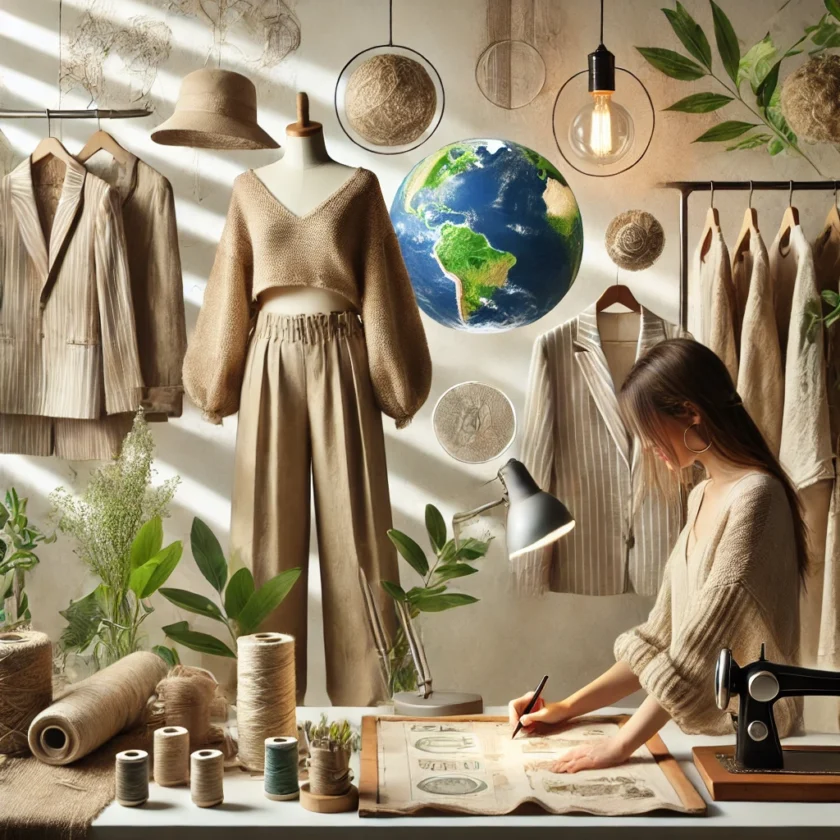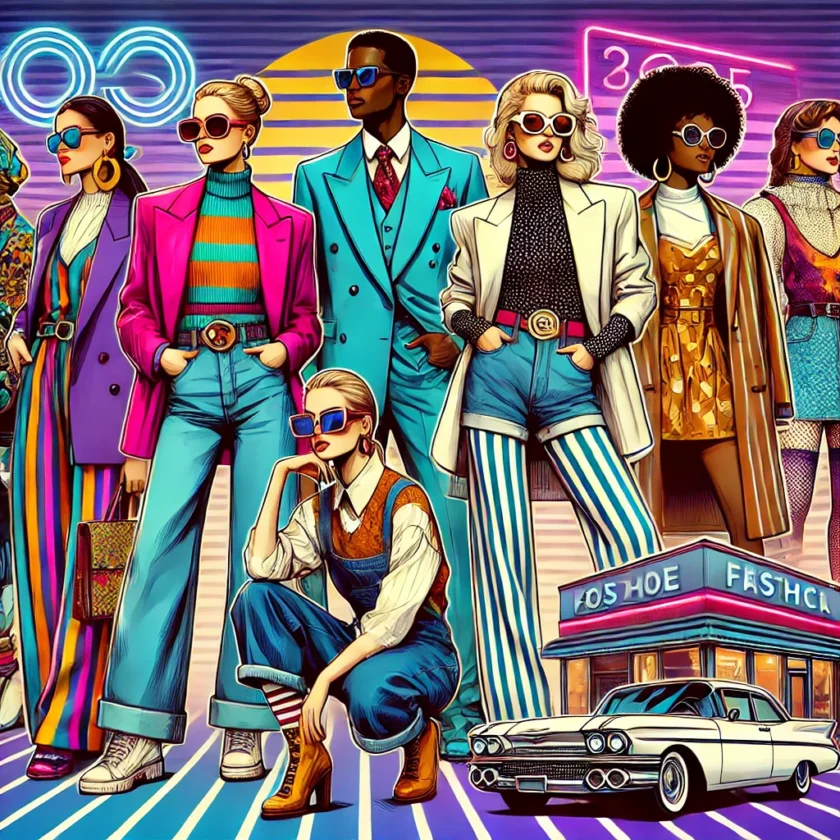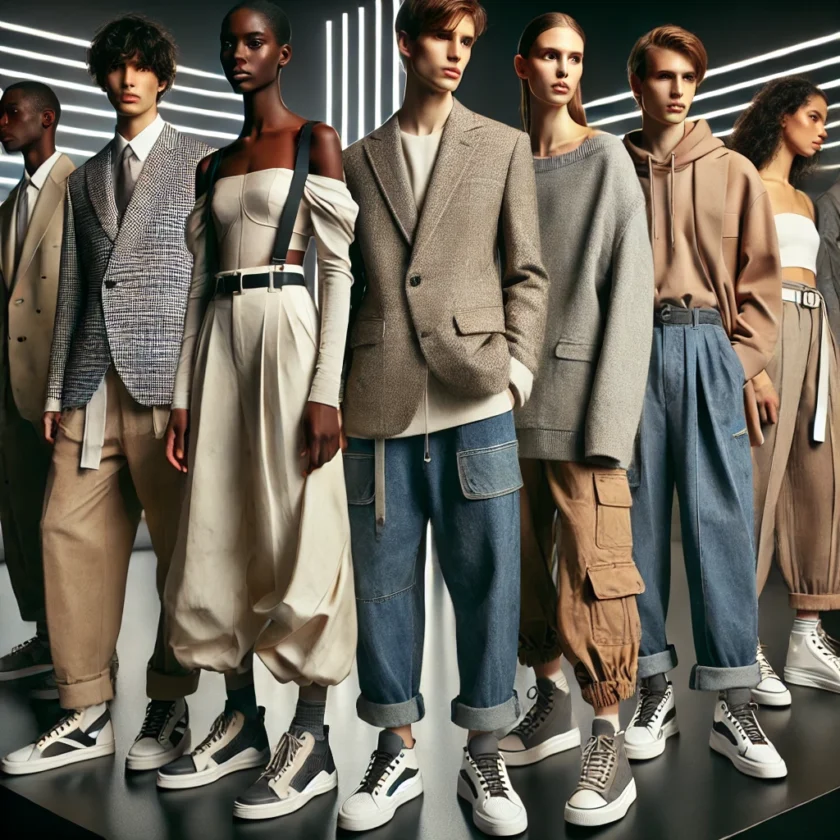Fashion is an ever-evolving industry that constantly reinvents itself, reflecting cultural shifts, technological advancements, and the changing tastes of consumers. As we enter 2025, the fashion world is buzzing with new trends while simultaneously bidding farewell to certain styles that have defined previous years.
From the resurgence of classic aesthetics to futuristic innovations, 2025 promises to be an exciting year for fashion enthusiasts. Whether you’re a trendsetter, a designer, or simply someone who enjoys keeping up with the latest styles, understanding what’s in and what’s out will help you stay ahead of the curve.
In this comprehensive guide, we’ll explore the top fashion trends dominating 2025, what’s making a comeback, and which styles are fading into obscurity.
1. The Dominance of Sustainable and Ethical Fashion

1.1 Sustainability as the New Standard
Sustainability is no longer a niche movement—it has become the new standard in the fashion industry. Consumers are increasingly demanding transparency from brands, pushing the industry towards environmentally friendly materials, ethical labor practices, and a circular economy. This shift is driven by heightened awareness of climate change, unethical labor conditions, and the massive waste produced by the fashion industry each year.
Some of the biggest developments in sustainable fashion for 2025 include:
- Upcycled and Recycled Materials – Brands are embracing the use of discarded textiles, plastic waste, and even ocean-recovered materials to create stylish, high-quality clothing.
- Vegan Leather and Plant-Based Fabrics – Leather alternatives like mushroom leather, apple leather, and cactus leather are growing in popularity, offering cruelty-free and sustainable options.
- Secondhand and Thrift Fashion – The resale market is booming as vintage shopping and thrifting gain mainstream popularity. More luxury brands are also launching certified secondhand programs to resell pre-owned goods, extending product lifespans.
- Eco-Friendly Dyeing and Water Conservation – Traditional dyeing methods contribute significantly to pollution, but new techniques using algae-based dyes and waterless dyeing processes are being widely adopted.
Luxury fashion houses, fast fashion retailers, and independent designers alike are aligning their business models with sustainable practices, knowing that future consumers will prioritize ethical production and environmental impact.
1.2 Fast Fashion’s Decline
As sustainability takes center stage, the fast fashion industry is facing scrutiny like never before. Consumers are becoming more conscious of the environmental and social consequences of mass-produced, cheaply made clothing. This has led to a growing movement toward quality over quantity.
Several factors are contributing to the decline of fast fashion:
- Consumer Awareness – Shoppers are more educated about the exploitative labor conditions, high carbon emissions, and excessive waste caused by fast fashion brands.
- Shift to Slow Fashion – Minimalist wardrobes, capsule collections, and timeless fashion are replacing the trend-driven disposable culture of the past.
- Government Regulations – Some countries are implementing stricter environmental laws and imposing fines on brands that fail to meet sustainability standards.
As fast fashion struggles, new sustainable alternatives are emerging, including rental fashion, digital fashion for virtual avatars, and repair-and-rewear business models that encourage customers to extend the life of their clothes rather than discard them.
2. Futuristic Fashion and High-Tech Fabrics

2.1 Smart Clothing and Wearable Technology
The intersection of fashion and technology is expanding rapidly, with futuristic designs and innovative materials becoming increasingly mainstream. The future of fashion isn’t just about aesthetics; it’s about functionality, sustainability, and enhancing daily life.
Smart clothing is set to revolutionize the industry by integrating cutting-edge technology into everyday wear. Key advancements include:
- Self-cleaning fabrics – Researchers have developed textiles embedded with nanoparticles that repel dirt, sweat, and bacteria, reducing the need for frequent washing.
- Temperature-regulating clothing – Innovative fabrics can now adjust to external weather conditions, keeping the wearer warm in winter and cool in summer.
- Wearable fitness technology – From biometric sensors embedded in workout apparel to yoga pants that offer real-time posture corrections, fitness-oriented smart clothing is growing in popularity.
- Augmented Reality (AR) fashion – Digital clothing that exists solely in virtual spaces allows consumers to “wear” exclusive designs in online worlds and social media.
2.2 3D-Printed Fashion on the Rise
3D printing is revolutionizing how clothes are designed and produced, offering endless possibilities for customization, zero-waste manufacturing, and futuristic aesthetics. Some of the key trends within this sector include:
- Custom-Fit Clothing – Instead of mass-produced sizes, consumers can now have garments 3D-printed to fit their exact body measurements.
- Zero-Waste Production – Traditional garment-making processes result in a lot of fabric waste, but 3D printing produces clothing with no excess material.
- Futuristic Silhouettes – High-fashion designers are experimenting with sculptural, avant-garde designs that would be impossible to create using traditional sewing techniques.
Fashion houses like Balenciaga, Iris van Herpen, and Gucci have already embraced tech-driven aesthetics, and in 2025, we can expect to see even more brands integrating digital innovation into their collections.
High-tech fashion isn’t just about looking futuristic; it also plays a practical role in enhancing daily life. From self-healing textiles to clothing embedded with solar panels, the way we wear and interact with fashion is changing dramatically.
3. The Return of Vintage and Retro Aesthetics

3.1 Y2K Fashion Continues to Dominate
The Y2K aesthetic has proven to have lasting power, evolving beyond a simple trend into a cultural movement. With its bright colors, playful textures, and futuristic metallics, Y2K fashion continues to be a staple in 2025.
- Cargo pants, baby tees, and futuristic metallics are still dominating streetwear and casual fashion.
- Low-rise jeans are making a bold return, now paired with structured tops and statement belts.
- Chunky sneakers, butterfly motifs, and rhinestone embellishments remain key elements of the Y2K revival.
3.2 80s and 90s Revival
While Y2K fashion dominates younger demographics, the 80s and 90s aesthetics are making a massive comeback in high fashion and street style.
- Power dressing is back – Oversized blazers, structured shoulders, and cinched waists define the new office chic.
- Grunge and alternative fashion – Ripped jeans, plaid shirts, and combat boots bring back the raw edge of 90s counterculture.
- Sporty retro styles – Vintage windbreakers, high-waisted track pants, and logo-heavy designs from brands like Adidas and Nike are making waves.
3.3 The Influence of Vintage Accessories
Accessories are playing a major role in defining the vintage aesthetic of 2025. Key trends include:
- Statement sunglasses – Retro-inspired oval, oversized, and cat-eye sunglasses dominate fashion weeks worldwide.
- Luxury handbags and reissued designs – Iconic bags from the 80s and 90s are being relaunched by top brands.
- Pearl necklaces, chain belts, and bucket hats – Bringing a touch of nostalgia to modern outfits.
4. Gender-Fluid and Androgynous Fashion

4.1 Breaking Traditional Gender Norms
Fashion in 2025 is embracing gender fluidity like never before. Designers and brands are moving away from rigid gender divisions and creating collections that focus on personal expression rather than societal expectations.
- Unisex collections – Many major fashion houses now have dedicated gender-neutral lines that incorporate relaxed fits, neutral color palettes, and minimalist aesthetics.
- Redefining masculinity and femininity – Traditional clothing categories are merging, with skirts, corsets, and dresses making their way into mainstream menswear, while structured suits and oversized silhouettes dominate women’s fashion.
- Runway and celebrity influence – High-profile celebrities continue to push boundaries by wearing androgynous fashion, further popularizing the movement.
4.2 The Rise of Skirts and Dresses for Men
Menswear in 2025 is experiencing one of its boldest evolutions yet, with skirts and dresses becoming increasingly mainstream.
- Luxury designers leading the charge – Brands like Gucci, Balenciaga, and Thom Browne are incorporating skirts into their menswear lines.
- Streetwear influence – Long tunics, kilts, and layered skirts over pants are becoming popular among younger generations.
- Cultural shift – The stigma around skirts and dresses for men is fading, with many seeing it as a form of creative expression rather than a gendered piece of clothing.
4.3 The Androgynous Suit Revolution
Suits are no longer confined to corporate environments; they have transformed into symbols of power, freedom, and self-expression.
- Oversized suits with relaxed tailoring – Both men and women are embracing looser silhouettes for a more casual yet sophisticated look.
- Gender-fluid tuxedos – Traditional tuxedo designs are being modernized with experimental cuts, colorful variations, and asymmetrical styling.
- Breaking color stereotypes – Soft pastels, bold patterns, and metallic fabrics are making formal wear more diverse and expressive.
4.4 Unisex Footwear and Accessories
Shoes and accessories are no longer bound by gender labels, offering more versatility and universal appeal.
- Chunky sneakers and platform shoes – These styles remain dominant, embraced by all genders for both fashion and comfort.
- Bags without boundaries – Crossbody bags, fanny packs, and tote bags are becoming more unisex, with practicality being the main focus.
- Jewelry for everyone – Chains, pearls, and oversized earrings are trending across all genders, erasing the divide between masculine and feminine styling.
4.5 Makeup and Grooming in Fashion
Beauty and self-care have become integral to gender-fluid fashion in 2025.
- Men wearing makeup – Male celebrities and influencers continue to normalize makeup as a form of self-expression.
- Androgynous beauty trends – Natural brows, bold eyeliners, and glossy lips are seen on people of all genders.
- Hair trends – Short, sharp haircuts alongside long, flowing styles are seen across gender lines, reinforcing a more fluid approach to beauty.
4.6 Fashion Beyond Gender: The Future of Inclusivity
Inclusivity is at the core of gender-fluid fashion, making clothing accessible to all.
- Adaptive and universal designs – Brands are creating designs that accommodate diverse body types and physical abilities.
- Personalized shopping experiences – Online retailers are introducing AI-driven size recommendations to move beyond gendered sizing.
- A shift in marketing – Campaigns and fashion shows are featuring more diverse representation, breaking old stereotypes.
5. Statement Accessories and Bold Styling
5.1 Maximalist Jewelry and Oversized Accessories
Minimalist jewelry has taken a backseat as bold, oversized accessories dominate the fashion scene.
- Chunky gold chains, stacked rings, and statement earrings – These elements add a luxurious and dramatic touch to any outfit.
- Pearls for all genders – Pearls are no longer confined to women’s fashion; they are being incorporated into menswear and androgynous looks.
- Layered accessories – Multiple necklaces, stacked bracelets, and mixed metal combinations define 2025’s jewelry trends.
5.2 Statement Belts and Layering Trends
Belts are making a powerful return, adding structure and detail to even the simplest outfits.
- Corset belts and waist-cinchers – These pieces are redefining silhouettes, enhancing form-fitting outfits.
- Layered belts over oversized pieces – Fashion-forward individuals are stacking belts over dresses, jackets, and even blazers for a dramatic effect.
- Bright colors and metallic finishes – Statement belts in neon shades and reflective textures are adding bold pops of color.
5.3 Dramatic Headwear and Gloves
Headwear and gloves are becoming essential elements of high-fashion styling in 2025.
- Wide-brim hats, bucket hats, and structured berets – These classic styles are being reinvented with modern materials and colors.
- Opera gloves and elbow-length leather gloves – These timeless accessories are making a comeback in both casual and formal fashion.
- Headscarves and hoods – Silk scarves and hooded designs add an air of mystery and elegance.
5.4 Sunglasses and Futuristic Eyewear Trends
Sunglasses are no longer just for sun protection; they are bold statement pieces that define entire looks.
- Oversized sunglasses with geometric frames – Bold shapes and tinted lenses dominate this year’s eyewear trends.
- High-tech smart glasses – Wearable technology is being incorporated into eyewear, featuring built-in augmented reality and enhanced UV protection.
- Retro-inspired styles – Aviators, cat-eye frames, and tinted lenses are making a strong comeback.
5.5 The Rise of Luxe Handbags and Functional Fashion
Luxury handbags are evolving beyond simple accessories into must-have statement pieces.
- Micro bags vs. oversized totes – The contrast between ultra-small handbags and oversized utility totes is a defining trend.
- Sculptural handbags – Abstract shapes, bold textures, and 3D designs are elevating handbags from accessories to art pieces.
- Convertible designs – Multi-functional bags that can transform between styles (backpacks to clutches, crossbodies to belt bags) are gaining traction.
6. The Influence of Cultural and Regional Fashion Trends
Fashion is increasingly becoming a global phenomenon where cultures blend, adapt, and influence one another. The rise of digital platforms, social media, and international collaborations has amplified the impact of regional styles on mainstream fashion. In 2025, cultural diversity is not just acknowledged—it is celebrated.
6.1 The Rise of Afrocentric Fashion
African-inspired fashion continues to gain prominence, showcasing bold prints, vibrant colors, and traditional craftsmanship in a contemporary setting.
- Ankara and Kente prints – These richly patterned textiles are now seen in high fashion, streetwear, and luxury collections.
- Handcrafted accessories – Beaded jewelry, tribal-inspired earrings, and woven bags are making their way into mainstream trends.
- Afro-futurism in fashion – A fusion of futuristic elements with African heritage is emerging in haute couture and everyday wear.
6.2 The Growing Popularity of Asian Streetwear
Asian fashion hubs like Seoul, Tokyo, and Shanghai are dictating the future of streetwear, bringing experimental silhouettes and cultural aesthetics to the forefront.
- Oversized and layered fits – Inspired by K-fashion, exaggerated proportions and deconstructed clothing define modern street style.
- Harajuku-inspired accessories – Playful, eccentric, and colorful elements from Japan’s Harajuku culture are reappearing in global trends.
- Luxury meets casual – The fusion of high fashion with casual streetwear, as seen in South Korea’s minimalist yet bold approach, continues to grow.
6.3 Latin American Influence on Global Trends
Latin American fashion is experiencing a surge in global appeal, incorporating rich textures, flowing fabrics, and artisanal techniques.
- Flamenco-inspired ruffles – Dramatic ruffles and voluminous skirts are appearing in both evening wear and casual styles.
- Handwoven textiles – Indigenous weaving techniques from countries like Mexico and Peru are becoming staples in contemporary design.
- Bright, festive color palettes – Vibrant reds, yellows, and blues dominate collections, reflecting the warmth and liveliness of Latin culture.
6.4 Middle Eastern and Modest Fashion’s Evolution
Modest fashion is no longer limited to specific religious or cultural groups—it has become an aesthetic embraced by a global audience.
- Luxury abayas and kaftans – These traditional garments are being reimagined with modern tailoring and embellishments.
- Modest athleisure – Sporty yet covered outfits cater to the growing demand for both fashion and functionality.
- Rich embroidery and gold accents – Middle Eastern opulence is influencing global fashion through intricate detailing and lavish materials.
6.5 The Revival of Indigenous and Ethical Fashion Movements
Indigenous fashion is being recognized for its cultural significance, ethical production methods, and sustainability-focused designs.
- Reviving lost textile techniques – Ancient weaving, dyeing, and crafting methods are being preserved and incorporated into high-end fashion.
- Eco-conscious approaches – Many indigenous designers focus on slow fashion, creating unique, high-quality garments with minimal environmental impact.
- Cultural storytelling through fashion – More brands are prioritizing authenticity and representation by working directly with indigenous communities.
6.6 The Globalization of Fashion and Cross-Cultural Fusion
As the world becomes more interconnected, fashion is becoming a reflection of multicultural exchanges and influences.
- Mixing cultural elements – A fusion of styles from different parts of the world is creating entirely new fashion aesthetics.
- Collaborations between designers worldwide – More brands are engaging in cross-cultural partnerships, blending traditions and innovation.
- Fashion as a tool for inclusivity and representation – The industry is shifting towards a more inclusive approach, ensuring that diverse voices and styles are represented on runways and in marketing campaigns.
Conclusion
Fashion in 2025 is all about innovation, nostalgia, and sustainability. From high-tech fabrics to gender-fluid designs, the industry is embracing a new era of inclusivity and creativity. As certain trends fade, fresh ideas continue to emerge, shaping the way we dress and express ourselves.
Whether you’re into futuristic aesthetics or classic vintage styles, this year offers something for everyone. Stay ahead of the trends by embracing what’s in, and saying goodbye to what’s out!




